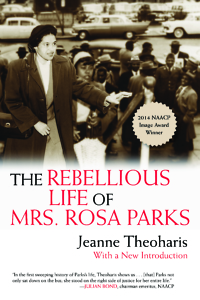A Rebellious Life
Jeanne Theoharis tells the story of the real Rosa Parks
Rosa Parks, the radical militant? We tend to think of the civil-rights pioneer as a quiet seamstress, but Parks was actually a tough activist who battled racial discrimination her entire life. Jeanne Theoharis illustrates this side of Parks in her book, The Rebellious Life of Mrs. Rosa Parks. A Distinguished Professor of Political Science at Brooklyn College, Theoharis is the author of numerous works on the black freedom struggle. Her writing has also appeared in The New York Times, The Washington Post, The Nation, and Smithsonian.

Theoharis answered questions via email for Chapter 16:
Chapter 16: Your book begins at the end: with the funeral of Rosa Parks. Why was her death the launching point for this biography?
Jeanne Theoharis: My original interest began with the ways she was being memorialized—and, by extension, how the movement was being represented. When she died in October 2005, she became the first woman and first civilian to lie in honor in the U.S. Capitol. But at the same time her legacy was made smaller. She was incessantly referred to as quiet, meek, soft-spoken, and trapped on that one day on the bus. The New York Times called her the “accidental matriarch” of the civil-rights movement. To me, there was nothing coincidental about having this national funeral for Rosa Parks less than two months after Hurricane Katrina. Honoring the lifelong freedom fighter Rosa Parks (who had insisted, to the end, that the struggle wasn’t over) became a way to put racism in the past—at a time when the federal negligence during Hurricane Katrina was forcing a necessary spotlight on enduring racial and economic injustice.
I did a talk on her funeral and the larger politics of historical memory. A colleague asked to turn it into a chapter for a book she was editing. That meant I had to fill out Rosa Parks’s actual history. I was astonished to realize that there was no serious, footnoted biography of her (despite tons of children’s and young-adult books)—which seemed to correspond to the argument I was making, which is that she was simultaneously being honored and reduced to a hero for children.
The more I looked, the more I saw how expansive her political history was—North and South, across the twentieth century, from organizing around the Scottsboro Trial to opposing Clarence Thomas’s nomination for the Supreme Court, from civil rights to Black Power, from anti-imperialism to labor rights. The more I looked, the more I realized what we didn’t know—and that even revisionist histories of her still dramatically missed her militancy, the expanse of her politics and working-class life, and the sacrifice her bus stand entailed for her and her family.
Chapter 16: Mrs. Parks was an activist long before the fateful day of December 1, 1955. How and why did she engage in the black struggle for freedom?
Theoharis: Rosa Parks was raised by her mother and grandparents, who instilled in her a sense of self-respect. Part of acting respectably was expecting and demanding respect from others. When Klan violence surged after World War I, Rosa Parks’s grandfather would sit out at night with his shotgun to protect the family home; a six-year old Rosa sometimes sat vigil with him. As a girl she defended herself and brother from white bullies and other indignities. Her grandmother worried that she would get herself lynched.
Her adult political activism began when she fell in love with and married a politically active barber named Raymond Parks. Raymond was working on defending the Scottsboro boys, and after they married she joined him in this work. In the early years, he was the more public activist, and she was more behind-the-scenes. That would change dramatically over the course of their marriage. In 1943, galled by the fact that black people (like her brother) were serving in World War II but not able to vote at home, Rosa Parks went to her first NAACP meeting. She made it known that she wanted to register to vote—and one of Montgomery’s most militant activists, E.D. Nixon (who led the local Brotherhood of Sleeping Car Porters), came by her home to bring her materials. This began a partnership that would change the face of American history. Over the next decade, Nixon and Parks would transform Montgomery’s NAACP into a more activist branch—working on issues of voter registration, desegregation, and criminal justice.
Chapter 16: Did Parks’s gender impose barriers upon her? Can her life tell us something, more broadly, about the role of women in the civil-rights movement?
Theoharis: Rosa Parks, like many women, played a key role in galvanizing, organizing, and pushing the movement forward over decades. She stood in the spotlight and did tons of behind-the-scenes work to keep the movement going. She was mentored by legendary organizers Ella Baker and Septima Clark.
But she also encountered barriers and gendered silences. Rosa Parks was turned into a symbol in the very first moments of the bus boycott in ways that often minimized her voice and the experience she brought to the struggle. Partly as a response to the repressive Cold War climate, her political experience was backgrounded—turning her into the “good Christian seamstress.” But then that image took on a life of its own, missing her substantial political vision and experience.
At the mass meeting on the first day of the boycott, she was up on the dais and given a minutes-long standing ovation but, despite calls for her to speak, she did not speak. Similarly, at the March on Washington, she was up on the dais with a handful of other women, but they did not get to speak. They were recognized in “A Tribute to Women” that march organizers put together when protests erupted that no women were among the featured speakers.
Five weeks after her bus arrest, Rosa Parks lost her job and shortly after, her husband was forced to give up his job. This plunged the Parks family into a decade of economic and health insecurity. While people fundraised for her at points along the way, civil-rights groups and leaders largely did not step in, which, I believe, partly had to do with the fact that Rosa Parks was a married woman. They did not see her economic situation as dire, as they would for a man who had been fired for his stand. Also, they believed that her husband should take care of her.
Chapter 16: Parks moved to Detroit soon after the bus boycott, and she lived longer there than in Alabama. What might her life reveal about the black-freedom struggle beyond the South?
Theoharis: Eight months after the boycott’s successful end, the Parks family still couldn’t find work and was still getting death threats. So they were forced to leave Montgomery and settled in Detroit, where her brother and cousins lived. She referred to Detroit as the “Northern promised land that wasn’t.” While some of the public signs of segregation were thankfully gone, she didn’t “find too much difference” between Montgomery and Detroit in the systems of school segregation, housing segregation, job exclusion, and police brutality. So Rosa Parks spent the next forty years of her life challenging the racism of the Jim Crow North.
For years, upon getting to Detroit, both Rosa and Raymond struggled to find work and decent, affordable housing. They were desperately poor and for a year served as caretakers for a social-service agency and lived in a two-room apartment with her mother. A 1960 Jet magazine article called her the “bus boycott’s forgotten woman” and described her as a “tattered rag of her former self.” She developed ulcers during the boycott that plagued her for years.
Despite her personal difficulties, Parks continued her activism. In 1964, she was volunteering on the longshot campaign of a young radical civil-rights lawyer for a new Michigan Congressional seat. Thirty-five-year-old John Conyers shared Parks’s commitment to labor issues and early opposition to U.S. involvement in Vietnam—Parks convinced Martin Luther King (who was staying away from all political races) to come to Detroit on Conyers’s behalf. Conyers partly credits this visit for his win in the primary by only about forty votes. One of the first things he did in 1965 was hire her for his Detroit office, doing constituent work and serving in the first years as his surrogate at many community events. She worked on issues of housing, social welfare, job discrimination, and policing. So Parks was on the ground and took part in a growing Black Power movement in the city and across the country.
 Chapter 16: Rosa Parks once called Malcolm X her hero. What was her political philosophy? Was she a radical?
Chapter 16: Rosa Parks once called Malcolm X her hero. What was her political philosophy? Was she a radical?
Theoharis: Yes, she was. What it took to challenge segregation and racial inequality was to not only imagine that a different world was possible, but also to face the pressure and condemnation that came down on those people who were willing to be rebels. The story we learn in school about Parks, even though it purports to honor her courage, misses what was actually courageous about her bus stand (and lifetime of activism). Rosa Parks knew full well what could happen if she resisted—her neighbor Hilliard Brooks had been killed by police for her bus stand, black women were raped in police custody, Claudette Colvin had been manhandled by police. She also had made stands before—as had people she knew—and there was nothing to suggest that taking this risk that December night would be any different. But she summoned the courage to do it anyway.
Parks wrote a lot about how difficult it was to be a rebel. Feeling like “puppets on the string in the white man’s hand,” Parks lamented how “we perform to their satisfaction or suffer the consequence if we get out of line.” Repeatedly, then, she underscored the pressure on black people not to dissent and the difficulties in mobilizing in the years before her bus stand. She noted how those who challenged the racial order were labeled “radicals, sore heads, agitators, trouble makers.” For years before her bus arrest, Parks struggled with the perils of being a rebel and the “wounds cut deeply by oppression,” but she determined to fight on, undergirded by her faith in God. Parks always took a great deal of hope from the militancy of young people—and across her life was willing to stand with young people, particularly in the growing Black Power movement.
She and Malcolm X met three times—the first in 1963 when he came to the city to address the Grassroots Leadership Conference. Malcolm deeply admired both Rosa Parks and Fannie Lou Hamer—and made it known to friends that he wanted to meet her. They met for the last time in 1965 when he came to give the keynote for an event by the Afro-American Broadcasting Company where Parks was getting an “Overdue Award.” She got him to sign her program.
Chapter 16: The Rebellious Life of Mrs. Rosa Parks was finished before the Library of Congress made available the 7,500 manuscript items in the Rosa Parks Papers. Have you since researched in this collection? If so, what have you learned?
Theoharis: When Howard Buffett donated the materials to the Library of Congress, I got to go through them and help the Library of Congress contextualize what was there. The materials amplify and extend some of the key arguments of the book: the central role she played not just in catalyzing the boycott but in sustaining it; how much and how deeply she and her family suffered economically and physically in the decade after her arrest; and the breadth and substance of her political work in Detroit and in the half century after the boycott. It requires us to grapple with her ideas and life experiences, not simply honor her symbol.
I have long critiqued the ways that Rosa Parks gets fixed in a single act and not treated as a serious political thinker and lifelong activist. The Rosa Parks Collection provides an exceptional glimpse of that, as well as a reckoning with her political voice, particularly during her Montgomery years. (Most of the writings and speeches that have survived appear to date from the mid-to-late 1950s.) On scraps of paper and backs of programs, flyers, and envelopes, Parks’s ideas come through about the system of segregation, about the toll of growing up in the segregated South, about the difficulty of being a rebel, and about the importance of resistance and the movement they were trying to build.

Aram Goudsouzian chairs the history department at the University of Memphis. His most recent book is Down to the Crossroads: Civil Rights, Black Power, and the Meredith March Against Fear.


